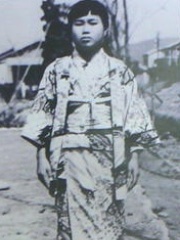
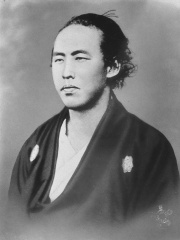
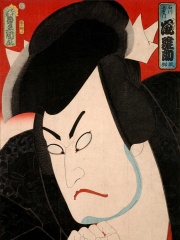
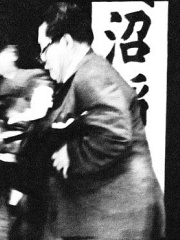
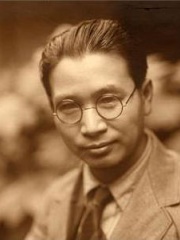
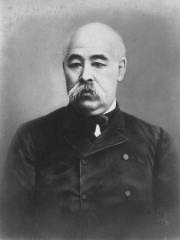
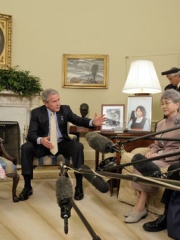
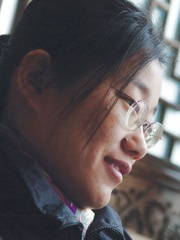
The Most Famous
SOCIAL ACTIVISTS from Japan
This page contains a list of the greatest Japanese Social Activists. The pantheon dataset contains 538 Social Activists, 10 of which were born in Japan. This makes Japan the birth place of the 12th most number of Social Activists behind Italy and Turkey.
Top 10
The following people are considered by Pantheon to be the top 10 most legendary Japanese Social Activists of all time. This list of famous Japanese Social Activists is sorted by HPI (Historical Popularity Index), a metric that aggregates information on a biography’s online popularity. Visit the rankings page to view the entire list of Japanese Social Activists.

1. Sadako Sasaki (1943 - 1955)
With an HPI of 69.39, Sadako Sasaki is the most famous Japanese Social Activist. Her biography has been translated into 44 different languages on wikipedia.
Sadako Sasaki (佐々木 禎子, Sasaki Sadako, January 7, 1943 – October 25, 1955) was a Japanese girl who became a victim of the atomic bombings of Hiroshima and Nagasaki by the United States. She was two years of age when the bombs were dropped and was severely irradiated. She survived for another ten years, becoming one of the most widely known hibakusha—a Japanese term meaning "bomb-affected person". She is remembered through the story of the more than one thousand origami cranes she folded before her death. She died at the age of 12 on October 25, 1955, at the Hiroshima Red Cross Hospital.

2. Sakamoto Ryōma (1836 - 1867)
With an HPI of 63.50, Sakamoto Ryōma is the 2nd most famous Japanese Social Activist. His biography has been translated into 32 different languages.
Sakamoto Ryōma (坂本龍馬 or 坂本竜馬, 3 January 1836 – 10 December 1867) was a Japanese samurai, a shishi and influential figure of the Bakumatsu, and establishment of the Empire of Japan in the late Edo period. Sakamoto was a low-ranking samurai from the Tosa Domain on Shikoku and became an active opponent of the Tokugawa Shogunate after the end of Japan's sakoku isolationist policy. Under the alias Saitani Umetarō (才谷梅太郎) he worked against the Bakufu, the government of the Tokugawa shogunate, and was often hunted by their supporters and the Shinsengumi. Sakamoto advocated for democracy, Japanese nationalism, return of power to the Imperial Court, abolition of feudalism, and moderate modernization and industrialization of Japan. Sakamoto successfully negotiated the Satchō Alliance between the powerful rival Chōshū and Satsuma domains and united them against the Bakufu. Sakamoto was assassinated in December 1867 with his companion Nakaoka Shintarō, shortly before the Boshin War and the Meiji Restoration.

3. Ishikawa Goemon (1558 - 1594)
With an HPI of 60.07, Ishikawa Goemon is the 3rd most famous Japanese Social Activist. His biography has been translated into 22 different languages.
Ishikawa Goemon (石川 五右衛門, Ishikawa Goemon, August 24, 1558 – October 8, 1594) was a legendary Japanese outlaw hero who stole gold and other valuables to give to the poor. He and his son were boiled alive in public after their failed assassination attempt on the Sengoku period warlord Toyotomi Hideyoshi. His legend lives on in contemporary Japanese popular culture, often giving him greatly exaggerated ninja skills.

4. Otoya Yamaguchi (1943 - 1960)
With an HPI of 57.96, Otoya Yamaguchi is the 4th most famous Japanese Social Activist. His biography has been translated into 26 different languages.
Otoya Yamaguchi (山口 二矢, Yamaguchi Otoya, 22 February 1943 – 2 November 1960) was a Japanese right-wing ultranationalist youth who assassinated Inejirō Asanuma, chairman of the Japan Socialist Party, on 12 October 1960. Yamaguchi rushed the stage and stabbed Asanuma with a wakizashi-like short sword while Asanuma was participating in a televised election debate at Hibiya Public Hall in Tokyo. Yamaguchi, who was 17 years of age at the time, had been a member of Bin Akao's far-right Greater Japan Patriotic Party, but had resigned earlier that year, just prior to the assassination. After being arrested and interrogated, Yamaguchi committed suicide while in a detention facility. Yamaguchi became a hero and a martyr to Japanese far-right groups, who as of 2022, have continued to hold commemorations to this day. Yamaguchi's actions inspired a number of copycat crimes, including the Shimanaka incident in 1961, and inspired Nobel Prize-winning novelist Kenzaburō Ōe's novellas Seventeen and Death of a Political Youth. A photograph of the Asanuma assassination taken by Japanese photojournalist Yasushi Nagao won World Press Photo of the Year for 1960 and the 1961 Pulitzer Prize.
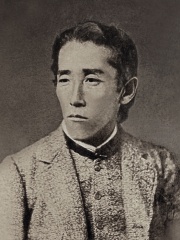
5. Itagaki Taisuke (1837 - 1919)
With an HPI of 54.20, Itagaki Taisuke is the 5th most famous Japanese Social Activist. His biography has been translated into 23 different languages.
Count Itagaki Taisuke (板垣 退助, 21 May 1837 – 16 July 1919) was a Japanese politician. He was a leader of the "Freedom and People's Rights Movement" and founded Japan's first political party, the Liberal Party.

6. Toyohiko Kagawa (1888 - 1960)
With an HPI of 50.33, Toyohiko Kagawa is the 6th most famous Japanese Social Activist. His biography has been translated into 18 different languages.
Toyohiko Kagawa (賀川 豊彦, Kagawa Toyohiko, 10 July 1888 – 23 April 1960) was a Japanese Evangelical Christian pacifist, Christian reformer, and labour activist. Kagawa wrote, spoke, and worked at length on ways to employ Christian principles in the ordering of society and in cooperatives. His vocation to help the poor led him to live among them. He advocated for women's suffrage and promoted a peaceful foreign policy.

7. Gotō Shōjirō (1838 - 1897)
With an HPI of 48.89, Gotō Shōjirō is the 7th most famous Japanese Social Activist. His biography has been translated into 18 different languages.
Count Gotō Shōjirō (後藤 象二郎, April 13, 1838 – August 4, 1897) was a Japanese samurai and politician during the Bakumatsu and early Meiji period of Japanese history. He was a leader of Freedom and People's Rights Movement (自由民権運動, jiyū minken undō) which would evolve into a political party.

8. Megumi Yokota (1964 - )
With an HPI of 46.30, Megumi Yokota is the 8th most famous Japanese Social Activist. Her biography has been translated into 17 different languages.
Megumi Yokota (横田 めぐみ, Yokota Megumi) (born 5 October 1964) is a Japanese citizen who was abducted by a North Korean agent in 1977 when she was a thirteen-year-old junior high school student. She was one of at least seventeen Japanese citizens kidnapped by North Korea in the late 1970s and early 1980s. The North Korean government has admitted to kidnapping Yokota, but has said that she died in captivity. Yokota's parents and others in Japan have publicly expressed the belief that she is still alive in North Korea and have waged a public campaign seeking her return to Japan.

9. Akira Amano (1973 - )
With an HPI of 43.20, Akira Amano is the 9th most famous Japanese Social Activist. Her biography has been translated into 21 different languages.
Akira Amano (天野 明, Amano Akira, born 1973) is a Japanese mangaka known for the shōnen series Reborn!. Early versions of Reborn! were published in seinen manga magazines. In late 2003, the series, a stand-alone short story at the time, was published in the Weekly Shōnen Jump magazine. After the success of the short story, the series began serialization in the magazine in mid-2004. Since then, the manga has been adapted into an anime, as well as five light novels and several video games. On Nikkei Entertainment's list of most successful manga artists she ranked 12th.
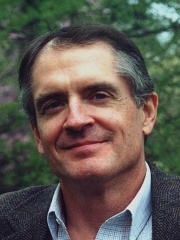
10. Jared Taylor (1951 - )
With an HPI of 40.59, Jared Taylor is the 10th most famous Japanese Social Activist. His biography has been translated into 18 different languages.
Samuel Jared Taylor (born September 15, 1951) is an American white supremacist and editor of American Renaissance, an online magazine espousing such opinions, which was founded by Taylor in 1990. He is also the president of American Renaissance's parent organization, New Century Foundation, through which many of his books have been published. He is a former member of the advisory board of The Occidental Quarterly and a former director of the National Policy Institute, a Virginia-based white nationalist think tank. He is also a board member and spokesperson of the Council of Conservative Citizens.Taylor and many of his affiliated organizations are accused of promoting racist ideologies by civil rights groups, news media, and academics studying racism in the United States.
Pantheon has 10 people classified as social activists born between 1558 and 1973. Of these 10, 3 (30.00%) of them are still alive today. The most famous living social activists include Megumi Yokota, Akira Amano, and Jared Taylor. The most famous deceased social activists include Sadako Sasaki, Sakamoto Ryōma, and Ishikawa Goemon.
Living Social Activists
Go to all Rankings
Megumi Yokota
1964 - Present
HPI: 46.30
Akira Amano
1973 - Present
HPI: 43.20
Jared Taylor
1951 - Present
HPI: 40.59

Deceased Social Activists
Go to all Rankings
Sadako Sasaki
1943 - 1955
HPI: 69.39
Sakamoto Ryōma
1836 - 1867
HPI: 63.50
Ishikawa Goemon
1558 - 1594
HPI: 60.07
Otoya Yamaguchi
1943 - 1960
HPI: 57.96
Itagaki Taisuke
1837 - 1919
HPI: 54.20
Toyohiko Kagawa
1888 - 1960
HPI: 50.33
Gotō Shōjirō
1838 - 1897
HPI: 48.89

Which Social Activists were alive at the same time? This visualization shows the lifespans of the 5 most globally memorable Social Activists since 1700.





